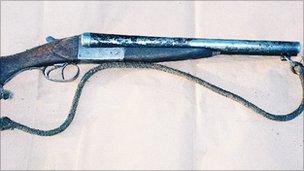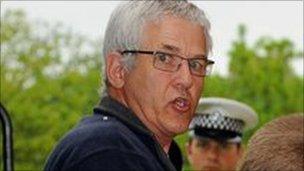Forensic advances finally led police to John Cooper
- Published

Among the items shown to the jury was the shotgun Cooper used to murder the Dixons in 1989 and items of clothing he wore while committing crimes
John Cooper has long been suspected of the two double murders that shook Pembrokeshire in the 1980s.
At one point there was speculation the Dixons died because they came across IRA weapons.
But when Cooper was arrested for burglaries and armed robbery in 1998 Dyfed-Powys Police also believed he had killed brother and sister Richard and Helen Thomas and Oxfordshire holidaymakers Peter and Gwenda Dixon and he was questioned at length.
Although the circumstantial evidence was strong, detectives lacked anything they could place before a jury that showed he was at the scenes of the crimes.
But while Cooper was in jail, having been sentenced to 16 years, a team of officers and forensic scientists worked quietly to build a case.
Det Ch Supt Steve Wilkins, who in 2005 was put in charge of a cold case review, said advances in forensic science provided the breakthrough.
"In the 1998 investigation he clearly was someone who was suspected of having involvement in those crimes but he demonstrated then, even faced with the strongest of connecting evidence to the offences, he still would not admit his guilt," he said.
"Certainly in discussions I've had with the senior investigating officers it was quite clear to them that they would need to have what we call the forensic golden nugget to connect him to those offences."
Between 1998 and 2005 police identified items recovered from Cooper's home, the scene of the robbery and the two murders, they hoped one day would convict him.
Taking over the case, Mr Wilkins had two big calls to make.

A major breakthrough came when Mr Dixon's DNA was found on shorts from Cooper's bedroom
One was to treat the killings of the Thomases in 1985, the Dixons in 1989 and the rape, sexual assault and attempted robberies of five teenagers at the Mount Estate in Milford Haven in 1996, as one inquiry.
The other was to sanction detailed forensic tests on key items including a pair of shorts from Cooper's bedroom, gloves from his house and a balaclava and double-barrelled shotgun found near the scene of the 1998 robbery.
"A number of the forensic techniques are destructive so you only get one chance," said DCS Wilkins.
"It came to the point in 2005 where I felt that [after discussions with advisers] there was unlikely to be further advances in forensic science in the foreseeable future and we felt then was the right time."
It was over two years before the first big breakthrough when traces of Mr Dixon's DNA were found on the shorts.
More followed and the prosecution was able to use fibres to link Cooper to all three crime scenes.
One of the crucial pieces of evidence the jury heard in this murder trial was a trace of Mr Dixon's blood was found underneath paint on the gun Cooper used in the robbery.
"Our case is essentially a forensic case though there is a lot of very interesting circumstantial and other physical evidence," said DCS Wilkins.
Confronting Cooper with the new evidence, police also changed tack in interviews.
"What came across very strongly was John Cooper is someone who thrives on control," added Mr Wilkins.
"Certainly in the early interviews we had episodes of him facing the wall, lying on the floor in a foetal position or exploding with anger.
"That [change] worked very well. We were very much able to get inside his mind and in doing so he effectively pointed us in the direction of places we needed to go.
"He is an individual who I believes thinks his capabilities are far above what they actually are.

Peter Dixon's blood was found on a shotgun Cooper used in a robbery in 1998
"That was a feature in his life where he had ideas. Unfortunately those ideas failed and that failure led him into the spiral of offending which started off with quite low level criminality, into burglary and escalated to robberies and ultimately into murdering his victims."
Throughout the investigation Mr Wilkins had support from the National Policing Improvement Agency (NPIA) which provides help to forces, particularly when they are running major investigations.
Among the support they provided were behavioural and psychological profiles.
NPIA adviser Paul Kemp said: "He [Cooper] was a compulsive type of person, very persistent in his approach to things and I think another factor was he had lost a lot of money through gambling.
"He had gone from owning quite a valuable paddock and house to living in rented accommodation and that had a major impact on the way he thought.
"If you look at the Thomases they owned a small farm and he may well have viewed that with envy."
Mr Kemp also emphasised the national importance of the case.
"We get involved in lots of high profile cases - the Cumbria shootings, the investigation of the Sian O'Callaghan murder over in Wiltshire, the murder of Joanna Yates," he said.
"They are all serious cases in their own right . . . but you don't get much more serious than this.

The murder allegations were first put to Cooper by police in 1998
"If you look at the absolute brutality of the offending, the possibility he could have offended again, the fact he committed two double murders and abducted and raped a young girl - this is a really really dangerous individual.
"In any community this would have enormous impact but because of the nature of this community - it's quite rural, quite a low population, crime is low in this area - the impact would be absolutely enormous."
Cooper was first questioned by police shortly after he executed the Thomases at the home in Scoveston Park on 22 December, 1985 as part of a general trawl for witnesses.
He was questioned again in 1989 when it was reported to police he had sold a wedding ring to a jeweller in Pembroke on 5 July - the day the Dixons' bodies were discovered hidden in undergrowth on the Pembrokeshire coastal path.
Mr Wilkins said he is certain there is nothing police could have done any differently to catch him earlier.
Speaking about the deaths of Mr and Mrs Thomas, he said: "I don't think there was anything that would have led the senior investigating officer at that time to believe he was a suspect or person of interest.
"Certainly he gave quite a plausible explanation which at that time was backed up by his family.
"In relation to the ring inquiry again, as is his nature, he gave a very plausible explanation. I can understand why he did not come in to the inquiry then.
"I am confident that nobody has been incompetent in relation to these investigations."